Three-Dimensional Mineral Prospectivity Modeling with the Integration of Ore-Forming Computational Simulation in the Xiadian Gold Deposit, Eastern China
Abstract
:1. Introduction
2. Geological Background
3. Methods
3.1. Dataset
3.2. 3D Modeling and Feature Extraction
3.3. Ore-Forming Simulation
3.3.1. Numerical Method
3.3.2. Model Setup
3.3.3. Initial and Boundary Conditions
3.4. 3D Prospectivity Modeling
4. Results and Discussion
4.1. Model and Feature Visualization
4.2. Ore-Forming Simulation Results
4.3. Model Comparison
4.4. Target Appraisal
5. Conclusions
Supplementary Materials
Author Contributions
Funding
Institutional Review Board Statement
Informed Consent Statement
Data Availability Statement
Acknowledgments
Conflicts of Interest
References
- Vearncombe, J.R.; Phillips, G.N. The importance of brownfields gold exploration. Miner. Depos. 2019, 55, 189–196. [Google Scholar] [CrossRef]
- McCuaig, T.C.; Beresford, S.; Hronsky, J. Translating the mineral systems approach into an effective exploration targeting system. Ore Geol. Rev. 2010, 38, 128–138. [Google Scholar] [CrossRef]
- Hagemann, S.G.; Lisitsin, V.A.; Huston, D.L. Mineral system analysis: Quo vadis. Ore Geol. Rev. 2016, 76, 504–522. [Google Scholar] [CrossRef]
- Wyman, D.A.; Cassidy, K.F.; Hollings, P. Orogenic gold and the mineral systems approach: Resolving fact, fiction and fantasy. Ore Geol. Rev. 2016, 78, 322–335. [Google Scholar] [CrossRef]
- Ford, A.; Peters, K.J.; Partington, G.A.; Blevin, P.L.; Downes, P.M.; Fitzherbert, J.A.; Greenfield, J.E. Translating expressions of intrusion-related mineral systems into mappable spatial proxies for mineral potential mapping: Case studies from the Southern New England Orogen, Australia. Ore Geol. Rev. 2019, 111, 102943. [Google Scholar] [CrossRef]
- Carranza, E.J.M.; Laborte, A.G. Random forest predictive modeling of mineral prospectivity with small number of prospects and data with missing values in Abra (Philippines). Comput. Geosci. 2015, 74, 60–70. [Google Scholar] [CrossRef]
- Rodriguez-Galiano, V.; Sanchez-Castillo, M.; Chica-Olmo, M.; Chica-Rivas, M. Machine learning predictive models for mineral prospectivity: An evaluation of neural networks, random forest, regression trees and support vector machines. Ore Geol. Rev. 2015, 71, 804–818. [Google Scholar] [CrossRef]
- Yousefi, M.; Nykänen, V. Data-driven logistic-based weighting of geochemical and geological evidence layers in mineral prospectivity mapping. J. Geochem. Explor. 2016, 164, 94–106. [Google Scholar] [CrossRef]
- Zhang, N.; Zhou, K.; Du, X. Application of fuzzy logic and fuzzy AHP to mineral prospectivity mapping of porphyry and hydrothermal vein copper deposits in the Dananhu-Tousuquan island arc, Xinjiang, NW China. J. Afr. Earth Sci. 2017, 128, 84–96. [Google Scholar] [CrossRef]
- Li, B.; Liu, B.; Guo, K.; Li, C.; Wang, B. Application of a Maximum Entropy Model for Mineral Prospectivity Maps. Minerals 2019, 9, 556. [Google Scholar] [CrossRef]
- Wang, J.; Zuo, R.; Xiong, Y. Mapping Mineral Prospectivity via Semi-supervised Random Forest. Nat. Resour. Res. 2019, 29, 189–202. [Google Scholar] [CrossRef]
- Li, X.; Yuan, F.; Zhang, M.; Jia, C.; Jowitt, S.M.; Ord, A.; Zheng, T.; Hu, X.; Li, Y. Three-dimensional mineral prospectivity modeling for targeting of concealed mineralization within the Zhonggu iron orefield, Ningwu Basin, China. Ore Geol. Rev. 2015, 71, 633–654. [Google Scholar] [CrossRef]
- Liu, L.; Li, J.; Zhou, R.; Sun, T. 3D modeling of the porphyry-related Dawangding gold deposit in south China: Implications for ore genesis and resources evaluation. J. Geochem. Explor. 2016, 164, 164–185. [Google Scholar] [CrossRef]
- Mao, X.; Ren, J.; Liu, Z.; Chen, J.; Tang, L.; Deng, H.; Bayless, R.C.; Yang, B.; Wang, M.; Liu, C. Three-dimensional prospectivity modeling of the Jiaojia-type gold deposit, Jiaodong Peninsula, Eastern China: A case study of the Dayingezhuang deposit. J. Geochem. Explor. 2019, 203, 27–44. [Google Scholar] [CrossRef]
- Chen, J.; Mao, X.; Deng, H.; Liu, Z.; Wang, Q. Three-dimensional modelling of alteration zones based on geochemical exploration data: An interpretable machine-learning approach via generalized additive models. Appl. Geochem. 2020, 123, 104781. [Google Scholar] [CrossRef]
- Malehmir, A.; Thunehed, H.; Tryggvason, A. The Paleoproterozoic Kristineberg mining area, northern Sweden: Results from integrated 3D geophysical and geologic modeling, and implications for targeting ore deposits. Geophysics 2009, 74, B9–B22. [Google Scholar] [CrossRef]
- Li, W.; Qian, J.; Li, Y. Joint inversion of surface and borehole magnetic data: A level-set approach. Geophysics 2020, 85, J15–J32. [Google Scholar] [CrossRef]
- Li, W.; Lu, W.; Qian, J. A level-set method for imaging salt structures using gravity data. Geophysics 2016, 81, G27–G40. [Google Scholar] [CrossRef]
- Wang, J.; Mao, X.; Peng, C.; Chen, J.; Deng, H.; Liu, Z.; Wang, W.; Fu, Z.; Wang, C. Three-dimensional refined modelling of deep structures by using the level set method: Application to the Zhaoping detachment fault, Jiaodong Peninsula, China. Math. Geosci. 2023, 55, 229–262. [Google Scholar] [CrossRef]
- Nykänen, V.; Ojala, V.J. Spatial Analysis Techniques as Successful Mineral-Potential Mapping Tools for Orogenic Gold Deposits in the Northern Fennoscandian Shield, Finland. Nat. Resour. Res. 2007, 16, 85–92. [Google Scholar] [CrossRef]
- Lu, Y.; Liu, L.; Xu, G. Constraints of deep crustal structures on large deposits in the Cloncurry district, Australia: Evidence from spatial analysis. Ore Geol. Rev. 2016, 79, 316–331. [Google Scholar] [CrossRef]
- Haddad-Martim, P.M.; Souza Filho, C.R.d.; Carranza, E.J.M. Spatial analysis of mineral deposit distribution: A review of methods and implications for structural controls on iron oxide-copper-gold mineralization in Carajás, Brazil. Ore Geol. Rev. 2017, 81, 230–244. [Google Scholar] [CrossRef]
- Parsa, M.; Maghsoudi, A.; Yousefi, M. Spatial analyses of exploration evidence data to model skarn-type copper prospectivity in the Varzaghan district, NW Iran. Ore Geol. Rev. 2018, 92, 97–112. [Google Scholar] [CrossRef]
- Nguemhe Fils, S.C.; Mimba, M.E.; Nyeck, B.; Nforba, M.T.; Kankeu, B.; Njandjock Nouck, P.; Hell, J.V. GIS-Based Spatial Analysis of Regional-Scale Structural Controls on Gold Mineralization along the Bétaré-Oya Shear Zone, Eastern Cameroon. Nat. Resour. Res. 2020, 29, 3457–3477. [Google Scholar] [CrossRef]
- Wang, F.-y.; Mao, X.-c.; Deng, H.; Zhang, B.-y. Manganese potential mapping in western Guangxi-southeastern Yunnan (China) via spatial analysis and modal-adaptive prospectivity modeling. Trans. Nonferrous Met. Soc. China 2020, 30, 1058–1070. [Google Scholar] [CrossRef]
- Liu, Z.; Chen, J.; Mao, X.; Tang, L.; Yu, S.; Deng, H.; Wang, J.; Liu, Y.; Li, S.; Bayless, R.C. Spatial association between orogenic gold mineralization and structures revealed by 3D prospectivity modeling: A case study of the Xiadian gold deposit, Jiaodong Peninsula, China. Nat. Resour. Res. 2021, 30, 3987–4007. [Google Scholar] [CrossRef]
- Mao, X.; Zhang, W.; Liu, Z.; Ren, J.; Bayless, R.C.; Deng, H. 3D mineral prospectivity modeling for the low-sulfidation epithermal gold deposit: A case study of the Axi gold deposit, Western Tianshan, NW China. Minerals 2020, 10, 233. [Google Scholar] [CrossRef]
- Yuan, F.; Li, X.; Zhang, M.; Jowitt, S.M.; Jia, C.; Zheng, T.; Zhou, T. Three-dimensional weights of evidence-based prospectivity modeling: A case study of the Baixiangshan mining area, Ningwu Basin, Middle and Lower Yangtze Metallogenic Belt, China. J. Geochem. Explor. 2014, 145, 82–97. [Google Scholar] [CrossRef]
- Li, N.; Bagas, L.; Li, X.; Xiao, K.; Li, Y.; Ying, L.; Song, X. An improved buffer analysis technique for model-based 3D mineral potential mapping and its application. Ore Geol. Rev. 2016, 76, 94–107. [Google Scholar] [CrossRef]
- Hu, X.; Yuan, F.; Li, X.; Jowitt, S.M.; Jia, C.; Zhang, M.; Zhou, T. 3D characteristic analysis-based targeting of concealed Kiruna-type Fe oxide-apatite mineralization within the Yangzhuang deposit of the Zhonggu orefield, southern Ningwu volcanic basin, middle-lower Yangtze River metallogenic Belt, China. Ore Geol. Rev. 2018, 92, 240–256. [Google Scholar] [CrossRef]
- Barnes, S.J.; Robertson, J.C. Time scales and length scales in magma flow pathways and the origin of magmatic Ni–Cu–PGE ore deposits. Geosci. Front. 2019, 10, 77–87. [Google Scholar] [CrossRef]
- Berger, B.R.; Tingley, J.V.; Drew, L.J. Structural localization and origin of compartmentalized fluid flow, Comstock Lode, Virginia City, Nevada. Econ. Geol. 2003, 98, 387–408. [Google Scholar] [CrossRef]
- Koegelenberg, C.; Kisters, A.F.M.; Harris, C. Structural controls of fluid flow and gold mineralization in the easternmost parts of the Karagwe-Ankole Belt of north-western Tanzania. Ore Geol. Rev. 2016, 77, 332–349. [Google Scholar] [CrossRef]
- Torremans, K.; Kyne, R.; Doyle, R.; Güven, J.F.; Walsh, J.J. Controls on metal distributions at the Lisheen and Silvermines deposits: Insights into fluid flow pathways in Irish-type Zn-Pb deposits. Econ. Geol. 2018, 113, 1455–1477. [Google Scholar] [CrossRef]
- Walsh, J.J.; Torremans, K.; Güven, J.; Kyne, R.; Conneally, J.; Bonson, C. Fault-Controlled Fluid Flow Within Extensional Basins and Its Implications for Sedimentary Rock-Hosted Mineral Deposits. In Metals, Minerals, and Society; Society of Economic Geologists: Littleton, CO, USA, 2018. [Google Scholar] [CrossRef]
- Chi, G.; Xue, C. An overview of hydrodynamic studies of mineralization. Geosci. Front. 2011, 2, 423–438. [Google Scholar] [CrossRef]
- Hobbs, B.; Zhang, Y.; Ord, A.; Zhao, C. Application of coupled deformation, fluid flow, thermal and chemical modelling to predictive mineral exploration. J. Geochem. Explor. 2000, 69, 505–509. [Google Scholar] [CrossRef]
- Li, Z.; Chi, G.; Bethune, K.M.; Eldursi, K.; Quirt, D.; Ledru, P.; Thomas, D. Interplay between thermal convection and compressional fault reactivation in the formation of unconformity-related uranium deposits. Miner. Depos. 2021, 56, 1389–1404. [Google Scholar] [CrossRef]
- Oliver, N.H.; McLellan, J.G.; Hobbs, B.E.; Cleverley, J.S.; Ord, A.; Feltrin, L. Numerical models of extensional deformation, heat transfer, and fluid flows across basement-cover interfaces during basin-related mineralization. Econ. Geol. 2006, 101, 1–31. [Google Scholar] [CrossRef]
- Ord, A.; Hobbs, B.; Zhang, Y.; Broadbent, G.; Brown, M.; Willetts, G.; Sorjonen-Ward, P.; Walshe, J.; Zhao, C. Geodynamic modelling of the century deposit, Mt Isa Province, Queensland. Aust. J. Earth Sci. 2002, 49, 1011–1039. [Google Scholar] [CrossRef]
- Zhang, Y.; Lin, G.; Roberts, P.; Ord, A. Numerical modelling of deformation and fluid flow in the Shuikoushan district, Hunan Province, South China. Ore Geol. Rev. 2007, 31, 261–278. [Google Scholar] [CrossRef]
- Zhang, Y.; Schaubs, P.; Zhao, C.; Ord, A.; Hobbs, B.; Barnicoat, A. Fault-related dilation, permeability enhancement, fluid flow and mineral precipitation patterns: Numerical models. Geol. Soc. Spec. Publ. 2008, 299, 239–255. [Google Scholar] [CrossRef]
- Zhao, C.; Hobbs, B.; Ord, A. Investigating porosity structure effects on hydrothermal mineralization patterns within permeable horizontal layers of fluid-saturated rocks: Semi-analytical approach through generic models. Ore Geol. Rev. 2022, 150, 105116. [Google Scholar] [CrossRef]
- Zhao, C.; Reid, L.B.; Regenauer-Lieb, K. Some fundamental issues in computational hydrodynamics of mineralization: A review. J. Geochem. Explor. 2012, 112, 21–34. [Google Scholar] [CrossRef]
- Li, Z.; Chi, G.; Bethune, K.M.; David, T.; Gerard, Z. Structural controls on fluid flow during compressional reactivation of basement faults: Insights from numerical modeling for the formation of unconformity-related uranium deposits in the Athabasca Basin, Canada. Econ. Geol. 2017, 112, 451–466. [Google Scholar] [CrossRef]
- Li, Z.; Chi, G.; Bethune, K.M.; Eldursi, K.; Quirt, D.; Ledru, P.; Gudmundson, G. Numerical simulation of strain localization and its relationship to formation of the Sue unconformity-related uranium deposits, eastern Athabasca Basin, Canada. Ore Geol. Rev. 2018, 101, 17–31. [Google Scholar] [CrossRef]
- Li, Z.; Chi, G.; Bethune, K.M.; Eldursi, K.; Thomas, D.; Quirt, D.; Ledru, P. Synchronous egress and ingress fluid flow related to compressional reactivation of basement faults: The Phoenix and Gryphon uranium deposits, southeastern Athabasca Basin, Saskatchewan, Canada. Miner. Depos. 2018, 53, 277–292. [Google Scholar] [CrossRef]
- Hu, X.; Li, X.; Yuan, F.; Ord, A.; Jowitt, S.M.; Li, Y.; Dai, W.; Ye, R.; Zhou, T. Numerical Simulation Based Targeting of the Magushan Skarn Cu–Mo Deposit, Middle-Lower Yangtze Metallogenic Belt, China. Minerals 2019, 9, 558. [Google Scholar] [CrossRef]
- Shan, W.; Mao, X.; Liu, Z.; Deng, H.; Tang, L.; Wang, D.; Pan, Y.; Liu, Y. Computational simulation of the ore-forming processes associated with the Sanshandao-Haiyu gold belt, Jiaodong Peninsula, eastern China: Implications for the duration of ore formation. Front. Earth Sci. 2023, 11, 1154945. [Google Scholar] [CrossRef]
- Ford, A.; Blenkinsop, T.G.; McLellan, J. Factors affecting fluid flow in strike–slip fault systems: Coupled deformation and fluid flow modelling with application to the western Mount Isa Inlier, Australia. Geofluids 2009, 9, 2–23. [Google Scholar] [CrossRef]
- Wilson, C.J.; Osborne, D.J.; Robinson, J.A.; Miller, J.M. Structural constraints and localization of gold mineralization in Leather Jacket Lodes, Ballarat, Victoria, Australia. Econ. Geol. 2016, 111, 1073–1098. [Google Scholar] [CrossRef]
- Deng, J.; Yang, L.-Q.; Groves, D.I.; Zhang, L.; Qiu, K.-F.; Wang, Q.-F. An integrated mineral system model for the gold deposits of the giant Jiaodong province, eastern China. Earth Sci. Rev. 2020, 208, 103274. [Google Scholar] [CrossRef]
- Goldfarb, R.J.; Santosh, M. The dilemma of the Jiaodong gold deposits: Are they unique? Geosci. Front. 2014, 5, 139–153. [Google Scholar] [CrossRef]
- Deng, J.; Yang, L.-Q.; Li, R.-H.; Groves, D.I.; Santosh, M.; Wang, Z.-L.; Sai, S.-X.; Wang, S.-R.; Li, S. Regional structural control on the distribution of world-class gold deposits: An overview from the Giant Jiaodong Gold Province, China. Geol. J. 2019, 54, 378–391. [Google Scholar] [CrossRef]
- Guo, L.-N.; Goldfarb, R.J.; Wang, Z.-L.; Li, R.-H.; Chen, B.-H.; Li, J.-L. A comparison of Jiaojia- and Linglong-type gold deposit ore-forming fluids: Do they differ? Ore Geol. Rev. 2017, 88, 511–533. [Google Scholar] [CrossRef]
- Song, M.; Song, Y.; Ding, Z.; Wei, X.; Sun, S.; Song, G.; Zhang, J.; Zhang, P.; Wang, Y. The discovery of the Jiaojia and the Sanshandao giant gold deposits in Jiaodong Peninsula and discussion on the relevant issues. Geotecton. Metallog. 2019, 43, 92–110. [Google Scholar] [CrossRef]
- Yang, L.-Q.; Deng, J.; Wang, Z.-L.; Guo, L.-N.; Li, R.-H.; Groves, D.I.; Danyushevsky, L.V.; Zhang, C.; Zheng, X.-L.; Zhao, H. Relationships between gold and pyrite at the Xincheng gold deposit, Jiaodong Peninsula, China: Implications for gold source and deposition in a brittle epizonal environment. Econ. Geol. 2016, 111, 105–126. [Google Scholar] [CrossRef]
- Yang, L.; Zhao, R.; Wang, Q.; Liu, X.; Carranza, E.J.M. Fault geometry and fluid-rock reaction: Combined controls on mineralization in the Xinli gold deposit, Jiaodong Peninsula, China. J. Struct. Geol. 2018, 111, 14–26. [Google Scholar] [CrossRef]
- Yu, X.; Shan, W.; Xiong, Y.; Geng, K.; Sun, Y.; Chi, N.; Guo, B.; Li, D.; Li, H.; Song, Y. Deep structural framework and genetic analysis of gold concentration areas in the Northwestern Jiaodong Peninsula, China: A new understanding based on high-resolution reflective seismic survey. Acta Geol. Sin.-Engl. Ed. 2018, 92, 1823–1840. [Google Scholar] [CrossRef]
- Zhang, L.; Groves, D.I.; Yang, L.-Q.; Wang, G.-W.; Liu, X.-D.; Li, D.-P.; Song, Y.-X.; Shan, W.; Sun, S.-C.; Wang, Z.-K. Relative roles of formation and preservation on gold endowment along the Sanshandao gold belt in the Jiaodong gold province, China: Importance for province- to district-scale gold exploration. Miner. Depos. 2020, 55, 325–344. [Google Scholar] [CrossRef]
- Fan, H.R.; Zhai, M.G.; Xie, Y.H.; Yang, J.H. Ore-forming fluids associated with granite-hosted gold mineralization at the Sanshandao deposit, Jiaodong gold province, China. Miner. Depos. 2003, 38, 739–750. [Google Scholar] [CrossRef]
- Li, L.; Santosh, M.; Li, S.-R. The ‘Jiaodong type’ gold deposits: Characteristics, origin and prospecting. Ore Geol. Rev. 2015, 65, 589–611. [Google Scholar] [CrossRef]
- Liu, Z.; Mao, X.; Jedemann, A.; Bayless, R.C.; Deng, H.; Chen, J.; Xiao, K. Evolution of pyrite compositions at the Sizhuang gold deposit, Jiaodong Peninsula, Eastern China: Implications for the genesis of Jiaodong-type orogenic gold mineralization. Minerals 2021, 11, 344. [Google Scholar] [CrossRef]
- Yang, K.-F.; Jiang, P.; Fan, H.-R.; Zuo, Y.-B.; Yang, Y.-H. Tectonic transition from a compressional to extensional metallogenic environment at ∼120 Ma revealed in the Hushan gold deposit, Jiaodong, North China Craton. J. Asian Earth Sci. 2018, 160, 408–425. [Google Scholar] [CrossRef]
- Liu, Z.; Hollings, P.; Mao, X.; Lawley, C.J.M.; Yang, B.; Tang, L. Metal remobilization from country rocks into the Jiaodong-type orogenic gold systems, Eastern China: New constraints from scheelite and galena isotope results at the Xiadian and Majiayao gold deposits. Ore Geol. Rev. 2021, 134, 104126. [Google Scholar] [CrossRef]
- Liu, J.; Wang, J.; Liu, Y.; Tian, J.; Li, X.; Zhang, H.; Somerville, I. Ore genesis of the Xiadian gold deposit, Jiaodong Peninsula, East China: Information from fluid inclusions and mineralization. Geol. J. 2018, 53, 77–95. [Google Scholar] [CrossRef]
- Li, X.; Yuan, F.; Zhang, M.; Jowitt, S.M.; Ord, A.; Zhou, T.; Dai, W. 3D computational simulation-based mineral prospectivity modeling for exploration for concealed Fe–Cu skarn-type mineralization within the Yueshan orefield, Anqing district, Anhui Province, China. Ore Geol. Rev. 2019, 105, 1–17. [Google Scholar] [CrossRef]
- Xiang, J.; Xiao, K.; Carranza, E.J.M.; Chen, J.; Li, S. 3D mineral prospectivity mapping with random forests: A case study of Tongling, Anhui, China. Nat. Resour. Res. 2019, 29, 395–414. [Google Scholar] [CrossRef]
- Macêdo, I.; Gois, J.P.; Velho, L. Hermite radial basis functions implicits. In Comput Graph Forum; Blackwell Publishing Ltd.: Oxford, UK, 2011; pp. 27–42. [Google Scholar]
- Stein, M.L. Interpolation of Spatial Data: Some Theory for Kriging; Springer Science & Business Media: Berlin/Heidelberg, Germany, 1999. [Google Scholar]
- Carranza, E.J.M. Controls on mineral deposit occurrence inferred from analysis of their spatial pattern and spatial association with geological features. Ore Geol. Rev. 2009, 35, 383–400. [Google Scholar] [CrossRef]
- Deng, H.; Huang, X.; Mao, X.; Yu, S.; Chen, J.; Liu, Z.; Zou, Y. Generalized mathematical morphological method for 3D shape analysis of geological boundaries: Application in identifying mineralization-associated shape features. Nat. Resour. Res. 2021, 31, 2103–2127. [Google Scholar] [CrossRef]
- Gessner, K. Coupled models of brittle-plastic deformation and fluid flow: Approaches, methods, and application to Mesoproterozoic mineralisation at Mount Isa, Australia. Surv. Geophys. 2009, 30, 211–232. [Google Scholar] [CrossRef]
- Cui, T.; Yang, J.; Samson, I.M. Tectonic deformation and fluid flow: Implications for the formation of unconformity-related uranium deposits. Econ. Geol. 2012, 107, 147–163. [Google Scholar] [CrossRef]
- Liu, L.; Cao, W.; Liu, H.; Ord, A.; Qin, Y.; Zhou, F.; Bi, C. Applying benefits and avoiding pitfalls of 3D computational modeling-based machine learning prediction for exploration targeting: Lessons from two mines in the Tongling-Anqing district, eastern China. Ore Geol. Rev. 2022, 142, 104712. [Google Scholar] [CrossRef]
- Zhao, C. Advances in numerical algorithms and methods in computational geosciences with modeling characteristics of multiple physical and chemical processes. Sci. China Technol. Sci. 2015, 58, 783–795. [Google Scholar] [CrossRef]
- Zhao, C.; Hobbs, B.E.; Ord, A. Fundamentals of Computational Geoscience: Numerical Methods and Algorithms; Springer Science & Business Media: Berlin/Heidelberg, Germany, 2009; Volume 122. [Google Scholar]
- Itasca. FLAC3D 5.0 (Fast Lagrangian Analysis of Continua in 3 Dimensions) Manual; Itasca Consulting Group Inc.: Minneapolis, MN, USA, 2012. [Google Scholar]
- Eldursi, K.; Chi, G.; Bethune, K.; Li, Z.; Ledru, P.; Quirt, D. New insights from 2-and 3-D numerical modelling on fluid flow mechanisms and geological factors responsible for the formation of the world-class Cigar Lake uranium deposit, eastern Athabasca Basin, Canada. Miner. Depos. 2021, 56, 1365–1388. [Google Scholar] [CrossRef]
- Leader, L.D.; Robinson, J.A.; Wilson, C.J. Numerical modelling of fluid infiltration constrained by fault and bedding relationships in the Fosterville goldfield, Victoria, Australia. Ore Geol. Rev. 2012, 48, 384–402. [Google Scholar] [CrossRef]
- Cox, S.F. Faulting processes at high fluid pressures: An example of fault valve behavior from the Wattle Gully Fault, Victoria, Australia. J. Geophys. Res. Solid Earth 1995, 100, 12841–12859. [Google Scholar] [CrossRef]
- Cox, S.F. Coupling between deformation, fluid pressures, and fluid flow in ore-producing hydrothermal systems at depth in the crust. Econ. Geol. 2005, 100, 39–75. [Google Scholar] [CrossRef]
- Cox, S.F.; Knackstedt, M.A.; Brown, J. Principle of structural control on permeability and fluid flow in hydrothermal systems. In Structural Control on Ore Genesis. Reviews in Economic Geology; Richards, J.P., Tosdal, R.M., Eds.; Society of Economic Geologists: Littleton, CO, USA, 2001; Volume 14, pp. 1–24. [Google Scholar]
- Xie, S.; Mao, X.; Liu, Z.; Deng, H.; Chen, J.; Xiao, K. Determining the paleostress regime during the mineralization period in the Dayingezhuang Orogenic Gold Deposit, Jiaodong Peninsula, Eastern China: Insights from 3D numerical modeling. Minerals 2022, 12, 505. [Google Scholar] [CrossRef]
- Forcellini, D.; Alzabeebee, S. Seismic fragility assessment of geotechnical seismic isolation (GSI) for bridge configuration. Bull. Earthq. Eng. 2023, 21, 3969–3990. [Google Scholar] [CrossRef]
- Coleman, J.L.; Bolisetti, C.; Whittaker, A.S. Time-domain soil-structure interaction analysis of nuclear facilities. Nucl. Eng. Des. 2016, 298, 264–270. [Google Scholar] [CrossRef]
- Forcellini, D. Assessment of geotechnical seismic isolation (GSI) as a mitigation technique for seismic hazard events. Geosciences 2020, 10, 222. [Google Scholar] [CrossRef]
- Su, L.; Lu, J.; Elgamal, A.; Arulmoli, A.K. Seismic performance of a pile-supported wharf: Three-dimensional finite element simulation. Soil Dyn. Earthq. Eng. Struct. Dyn. 2017, 95, 167–179. [Google Scholar] [CrossRef]
- Caine, J.S.; Evans, J.P.; Forster, C.B. Fault zone architecture and permeability structure. Geology 1996, 24, 1025–1028. [Google Scholar] [CrossRef]
- Huang, L.; Wang, G.; Carranza, E.J.M.; Du, J.; Li, J.; Zhou, Z.; Zhang, Z.; Wang, H.; Liu, X.; Peng, Y. Multi-scale numerical simulation and 3D modeling for deep mineral exploration in the Jiaojia Gold District, China. Nat. Resour. Res. 2020, 29, 415–438. [Google Scholar] [CrossRef]
- Fournier, R.O. Hydrothermal processes related to movement of fluid from plastic into brittle rock in the magmatic-epithermal environment. Econ. Geol. 1999, 94, 1193–1211. [Google Scholar] [CrossRef]
- Charles, N.; Chen, Y.; Augier, R.; Gumiaux, C.; Lin, W.; Faure, M.; Monié, P.; Choulet, F.; Wu, F.; Zhu, R.; et al. Palaeomagnetic constraints from granodioritic plutons (Jiaodong Peninsula): New insights on Late Mesozoic continental extension in Eastern Asia. Phys. Earth Planet. Inter. 2011, 187, 276–291. [Google Scholar] [CrossRef]
- Yang, L.-Q.; Deng, J.; Wang, Z.-L.; Zhang, L.; Goldfarb, R.J.; Yuan, W.-M.; Weinberg, R.F.; Zhang, R.-Z. Thermochronologic constraints on evolution of the Linglong Metamorphic Core Complex and implications for gold mineralization: A case study from the Xiadian gold deposit, Jiaodong Peninsula, eastern China. Ore Geol. Rev. 2016, 72, 165–178. [Google Scholar] [CrossRef]
- Zuo, R.; Xiong, Y. Big data analytics of identifying geochemical anomalies supported by machine learning methods. Nat. Resour. Res. 2017, 27, 5–13. [Google Scholar] [CrossRef]
- Zuo, R.; Xiong, Y.; Wang, J.; Carranza, E.J.M. Deep learning and its application in geochemical mapping. Earth Sci. Rev. 2019, 192, 1–14. [Google Scholar] [CrossRef]
- Sun, T.; Chen, F.; Zhong, L.; Liu, W.; Wang, Y. GIS-based mineral prospectivity mapping using machine learning methods: A case study from Tongling ore district, eastern China. Ore Geol. Rev. 2019, 109, 26–49. [Google Scholar] [CrossRef]
- Mao, X.; Wang, J.; Deng, H.; Liu, Z.; Chen, J.; Wang, C.; Liu, J. Bayesian Decomposition Modelling: An Interpretable Nonlinear Approach for Mineral Prospectivity Mapping. Math. Geosci. 2023, 1–46. [Google Scholar] [CrossRef]
- Fan, J. Local linear regression smoothers and their minimax efficiencies. Ann. Stat. 1993, 21, 196–216. [Google Scholar] [CrossRef]
- Jessell, M.W.; Bons, P.D.; Evans, L.; Piazolo, S. Numerical Experiments into the Localization of Deformation during Recrystallization Flow. Mater. Sci. Forum 2004, 467–470, 647–652. [Google Scholar] [CrossRef]
- Zhang, Y.; Robinson, J.; Schaubs, P.M. Numerical modelling of structural controls on fluid flow and mineralization. Geosci. Front. 2011, 2, 449–461. [Google Scholar] [CrossRef]
- Wen, B.-J.; Fan, H.-R.; Santosh, M.; Hu, F.-F.; Pirajno, F.; Yang, K.-F. Genesis of two different types of gold mineralization in the Linglong gold field, China: Constrains from geology, fluid inclusions and stable isotope. Ore Geol. Rev. 2015, 65, 643–658. [Google Scholar] [CrossRef]
- Fawcett, T. An introduction to ROC analysis. Pattern Recognit. Lett. 2006, 27, 861–874. [Google Scholar] [CrossRef]
- Yu, X.; Yang, D.; Li, D.; Dan, W.; Xiong, Y.; Chi, N.; Liu, P.; Yu, L. Mineralization characteristics and geological significance in 3000m depth of Jiaojia gold metallogenic belt, Jiaodong Peninsula. Acta Petrol. Sin. 2019, 39, 2893–2910. [Google Scholar]
- Liu, G.; Wen, G.; Liu, C.; Bao, Z.; Sun, Z.; Fan, J.; Li, S.; Yan, C.; Guo, Z. Discovery, characteristics and prospecting direction of Shuiwangzhuang deep super-large gold deposit in the northern section of Zhaoping fault. Gold Sci. Technol. 2017, 25, 38. [Google Scholar] [CrossRef]
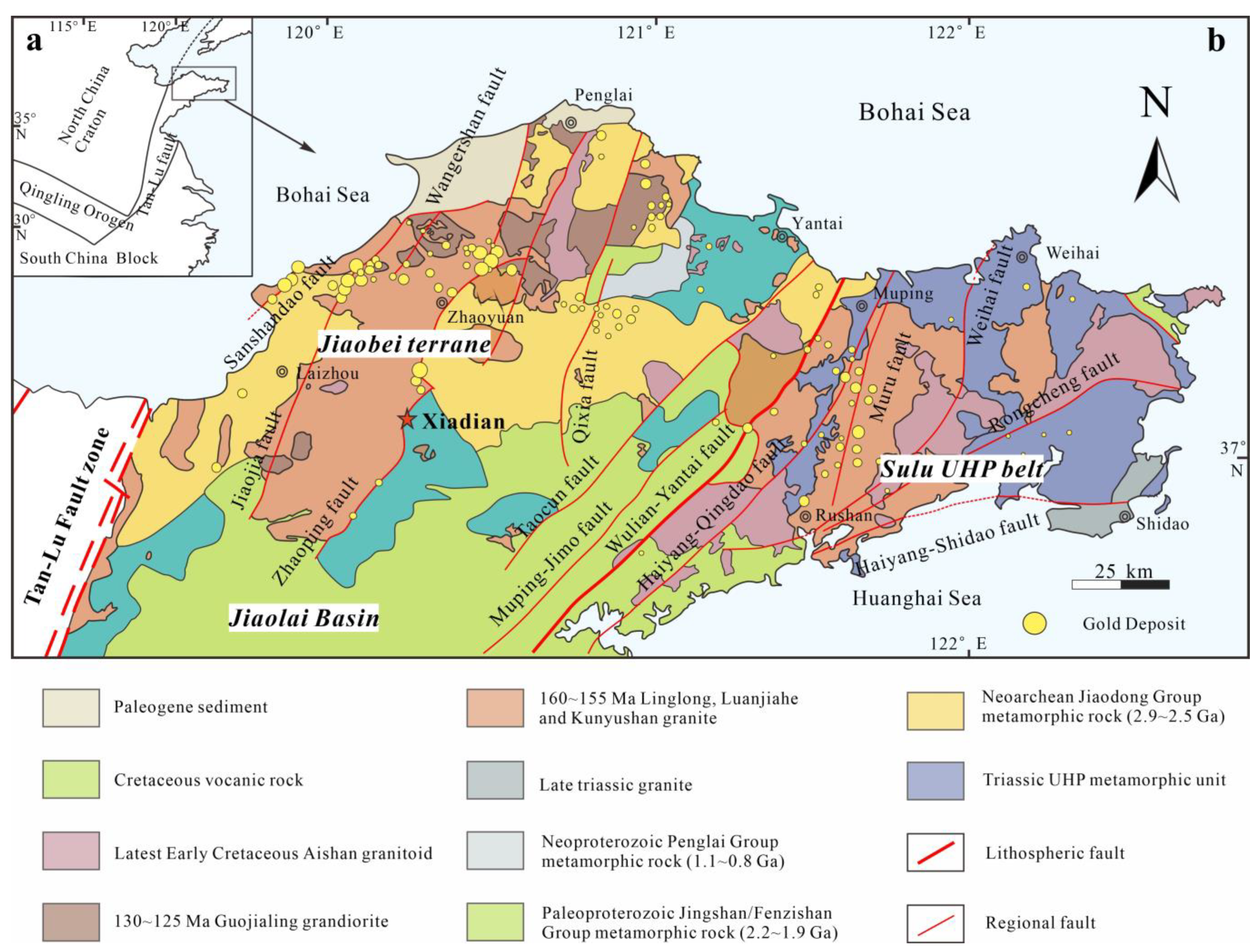
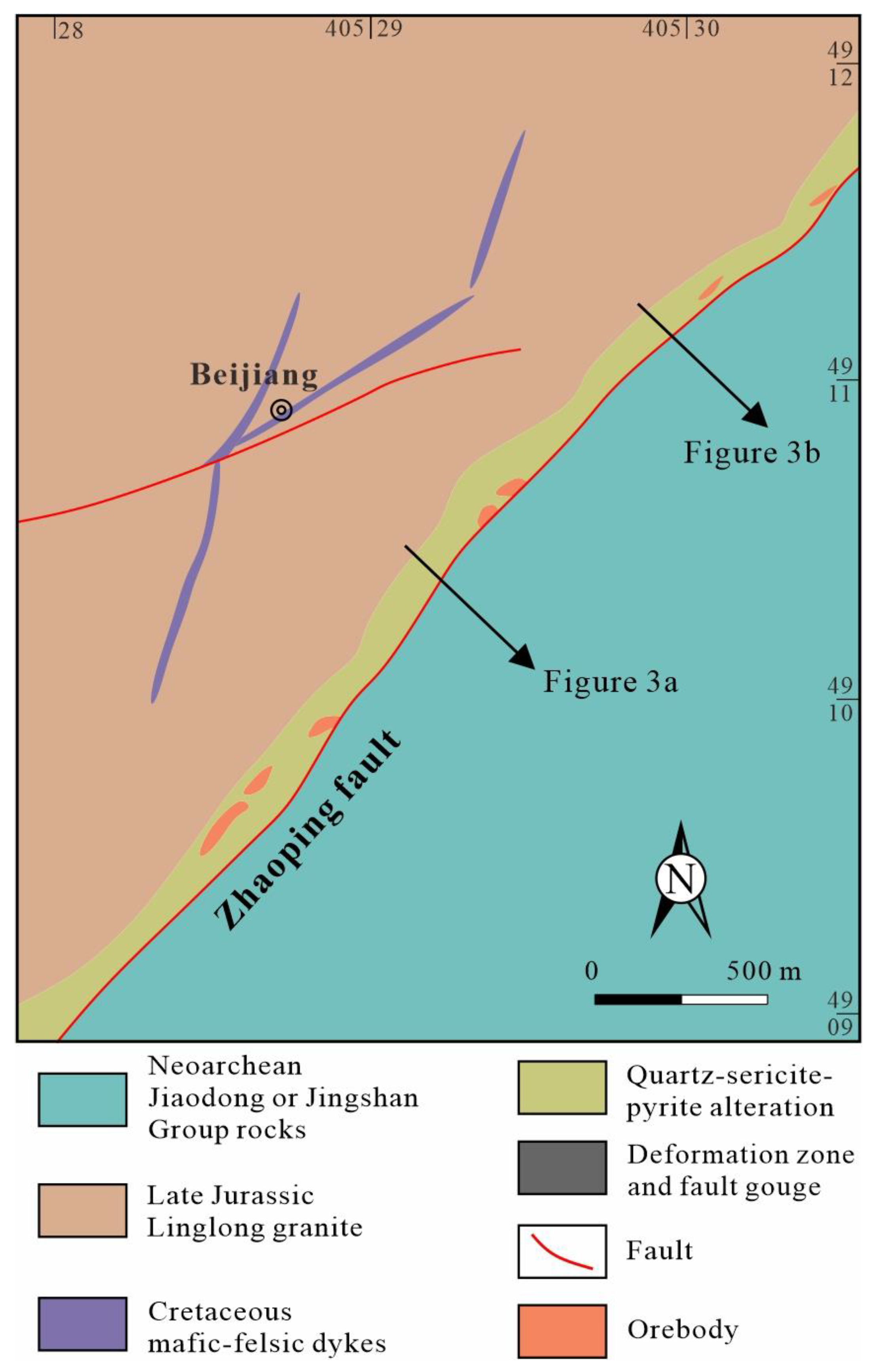

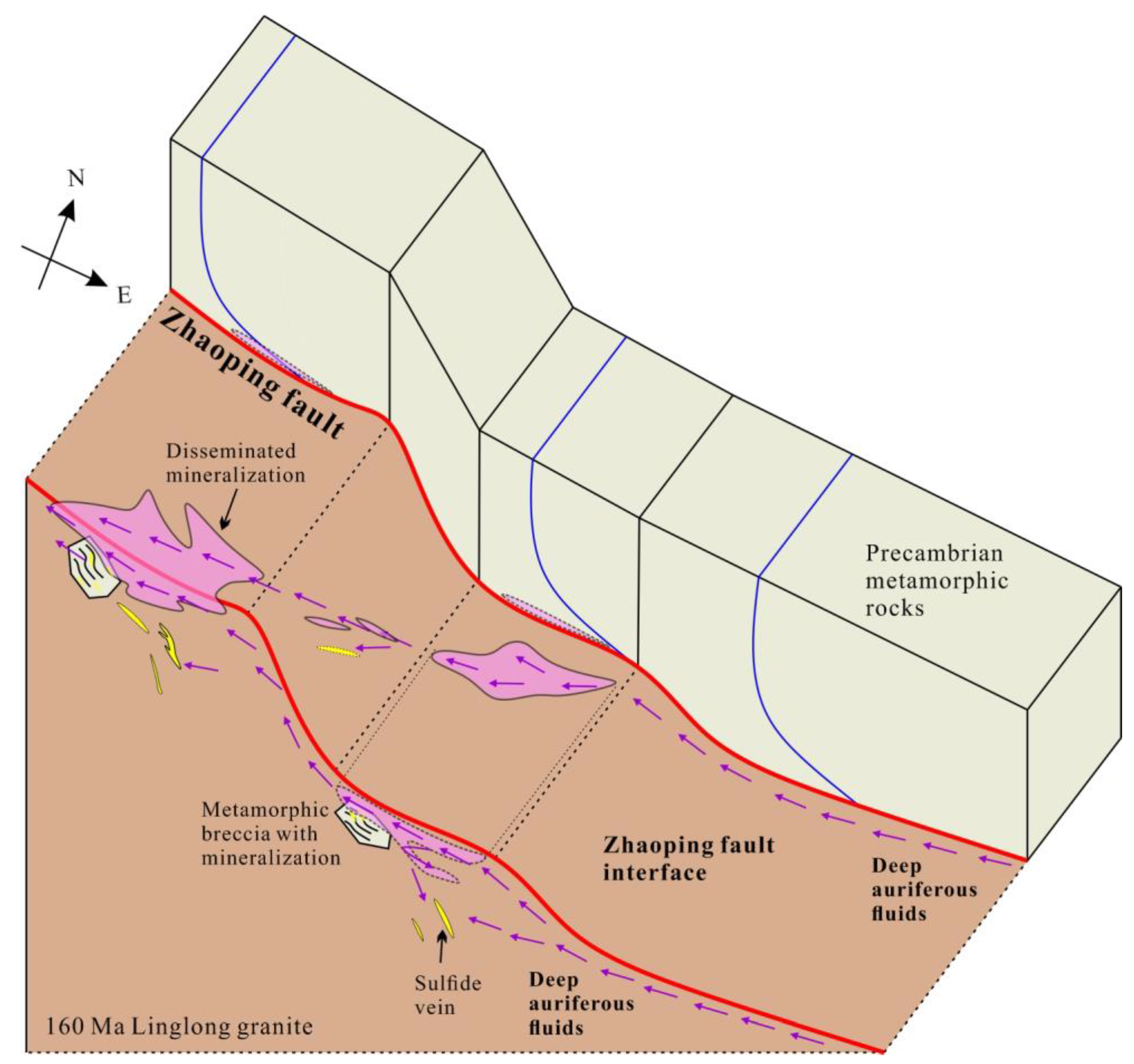
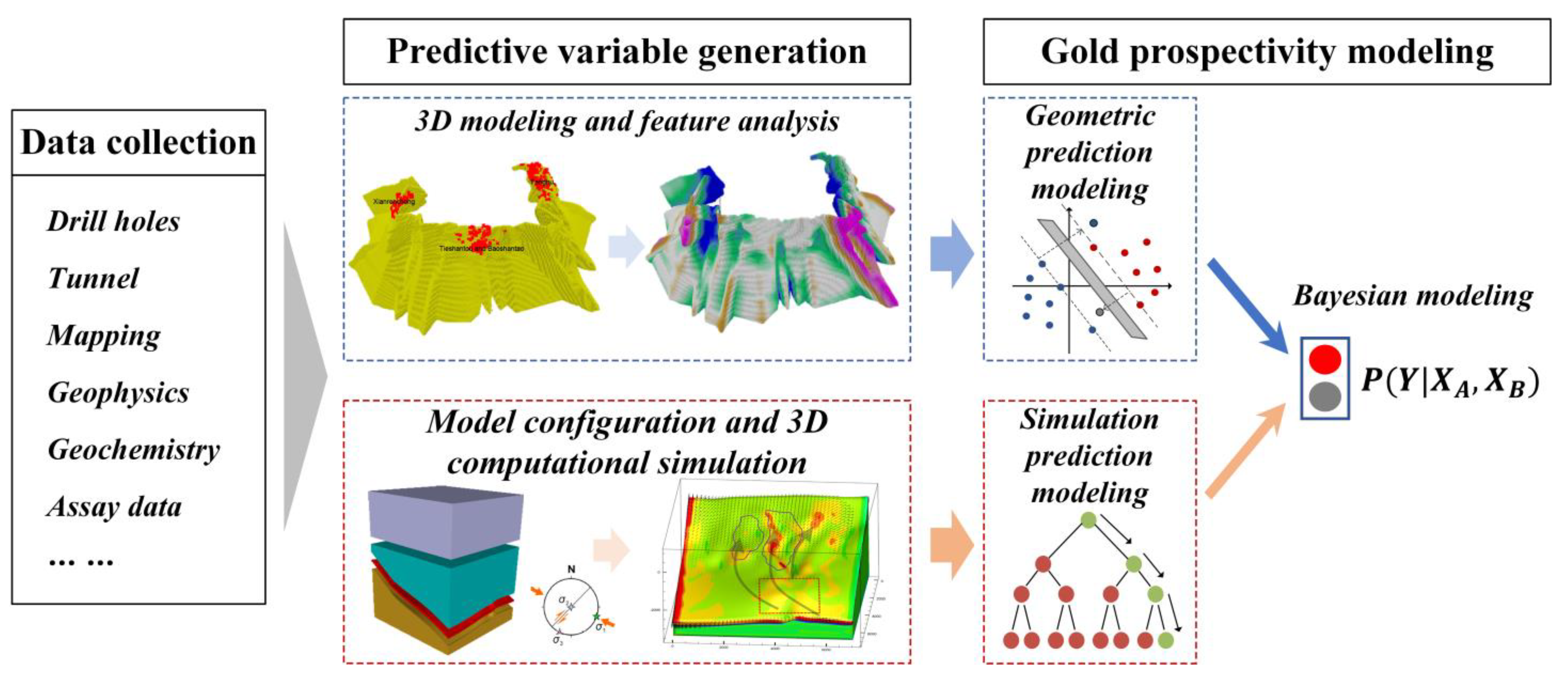
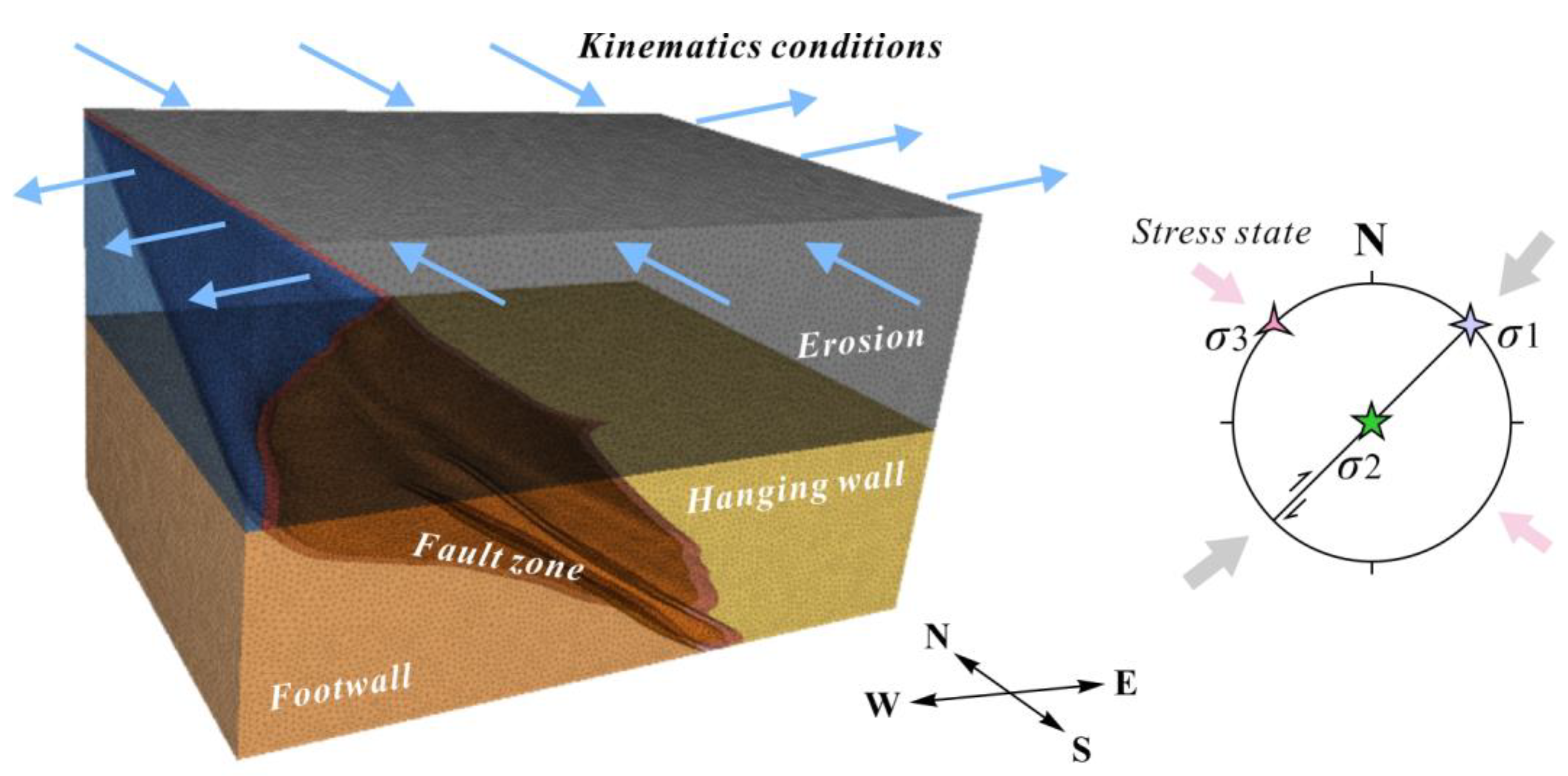
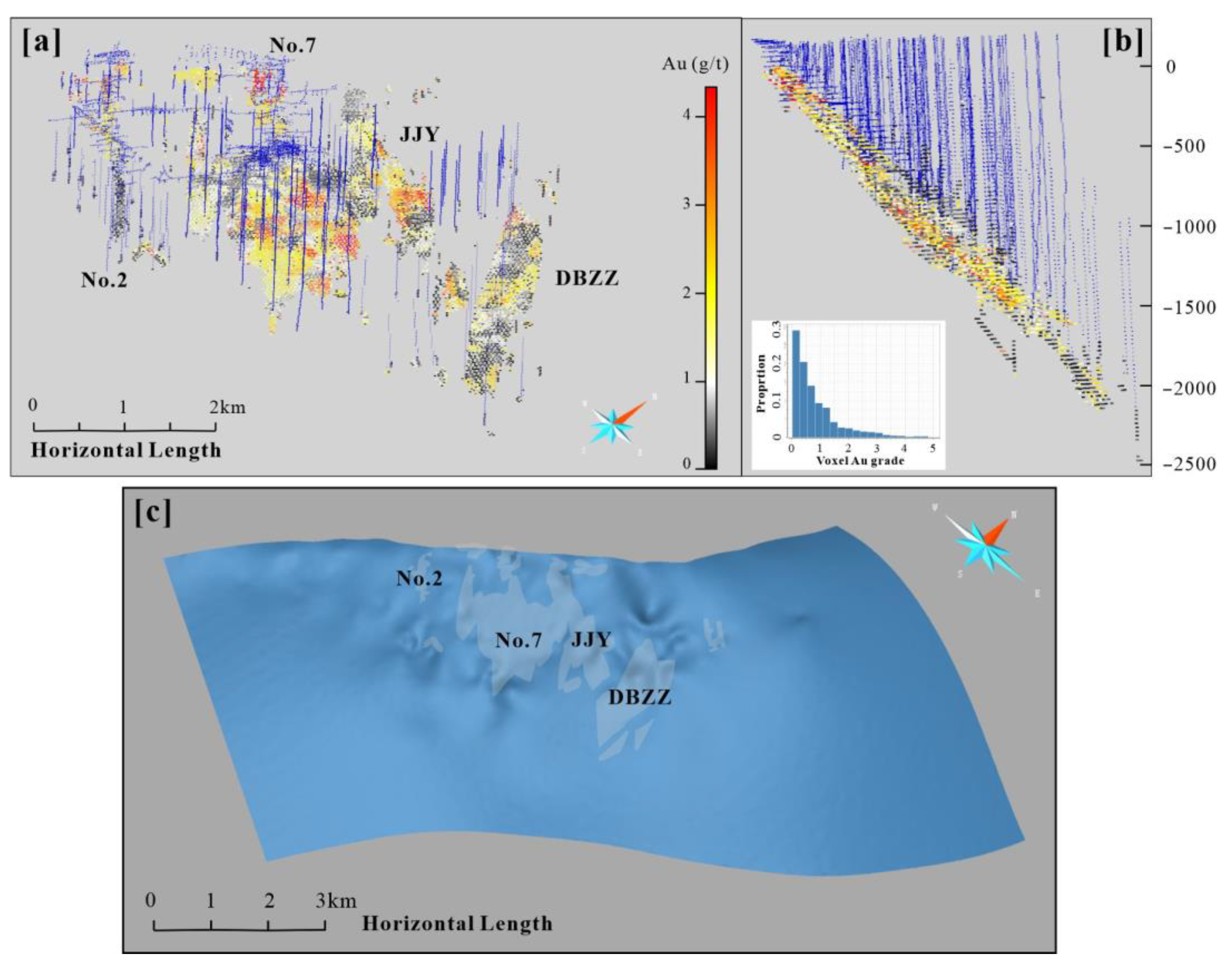
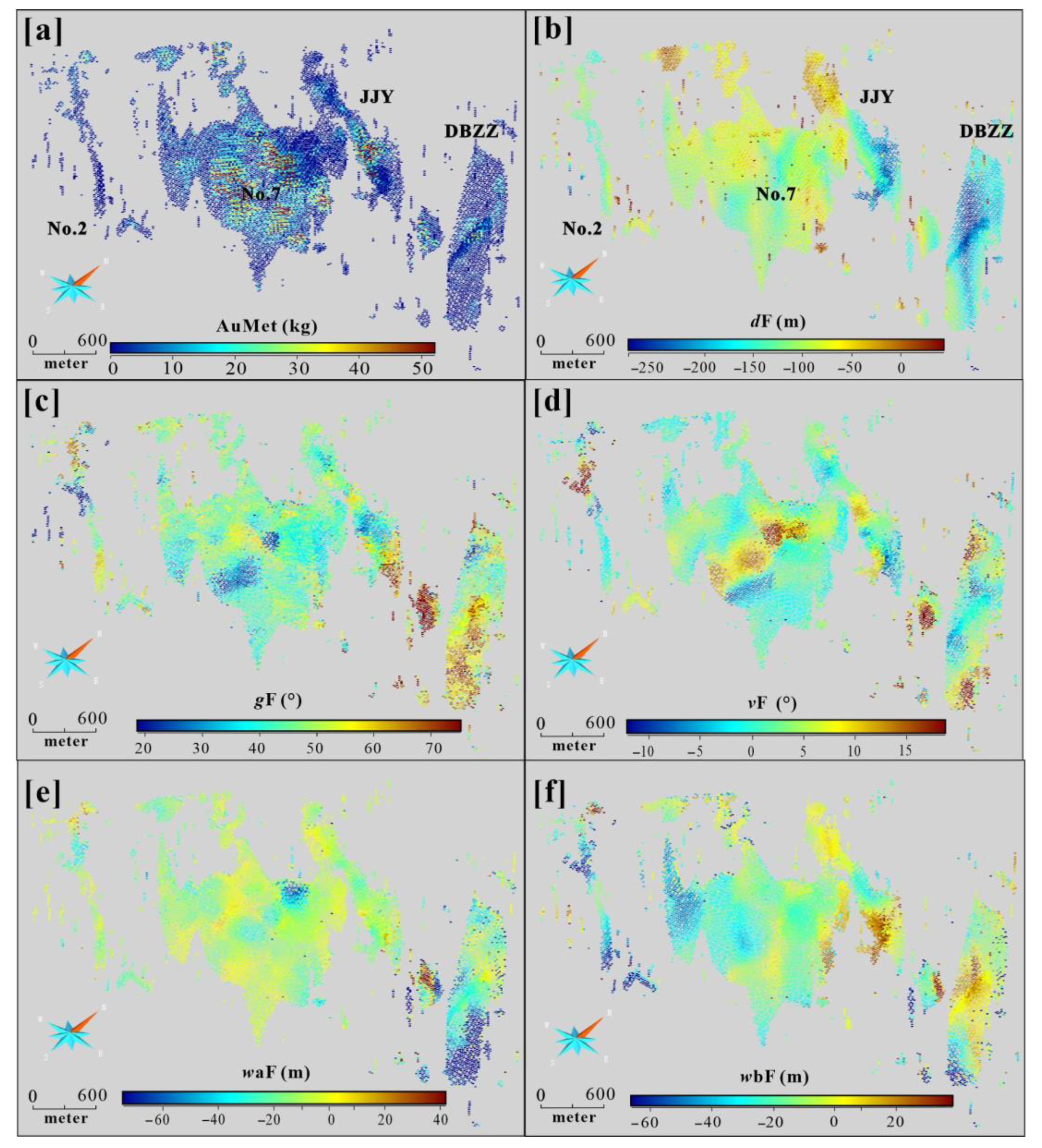
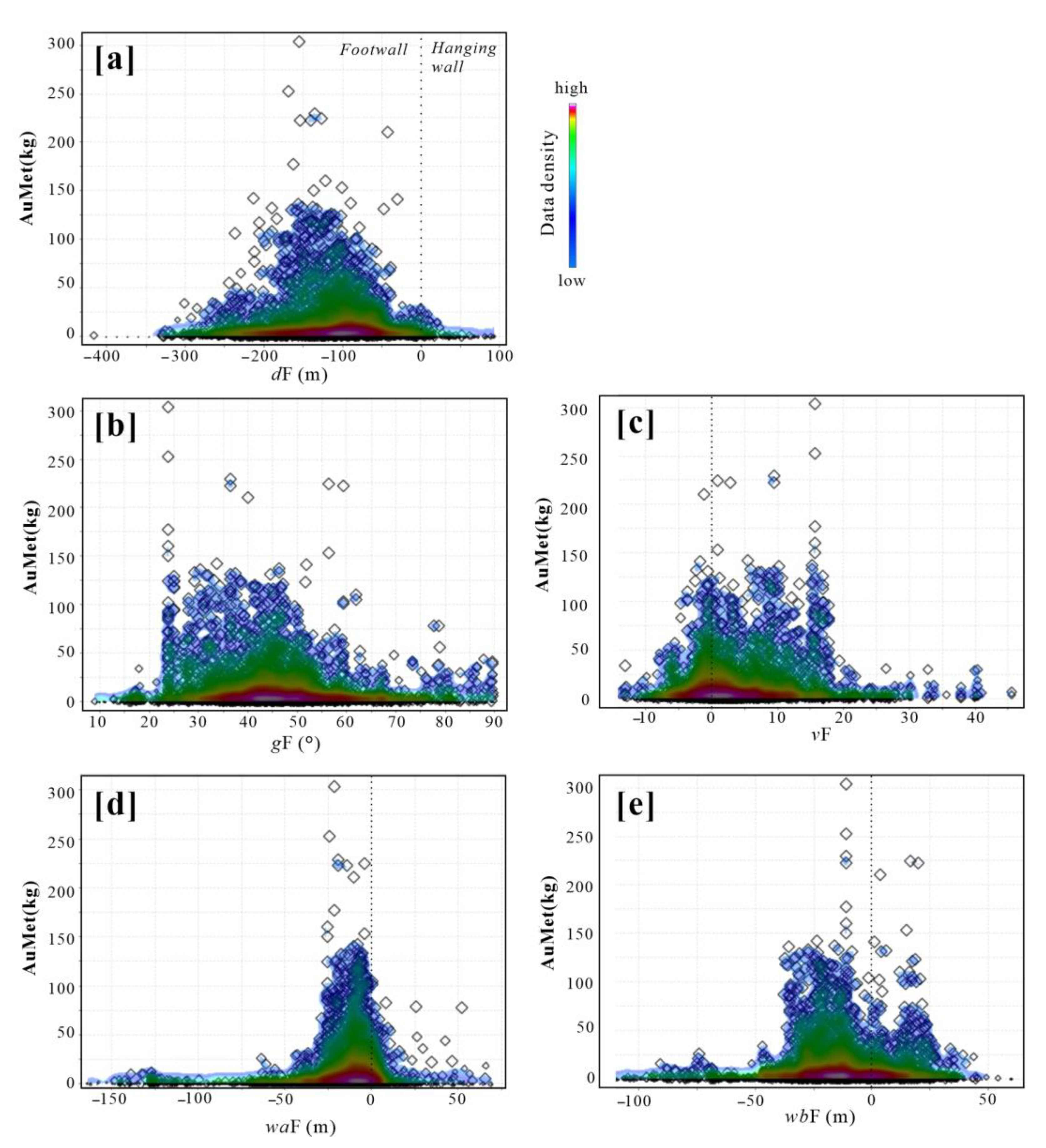
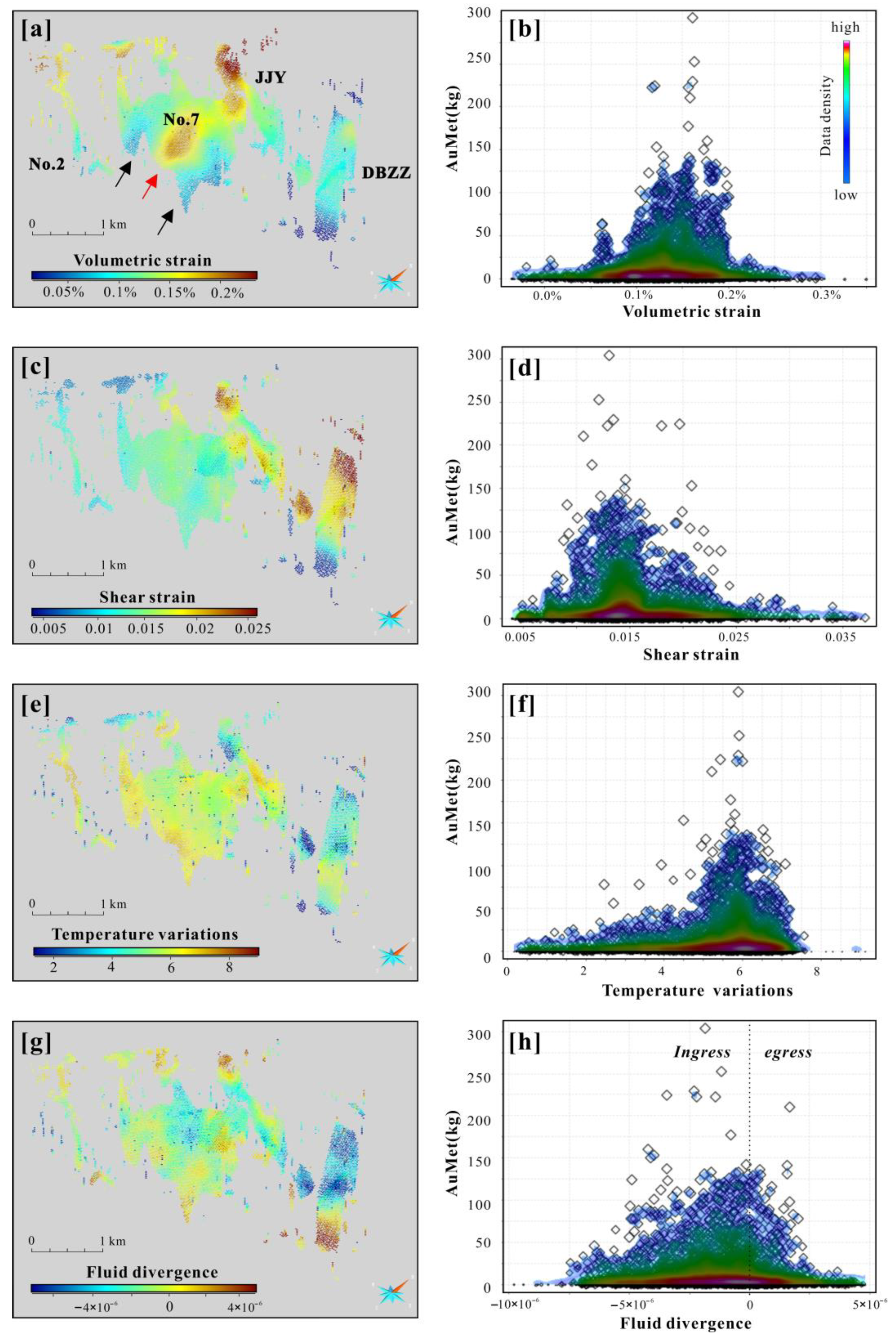
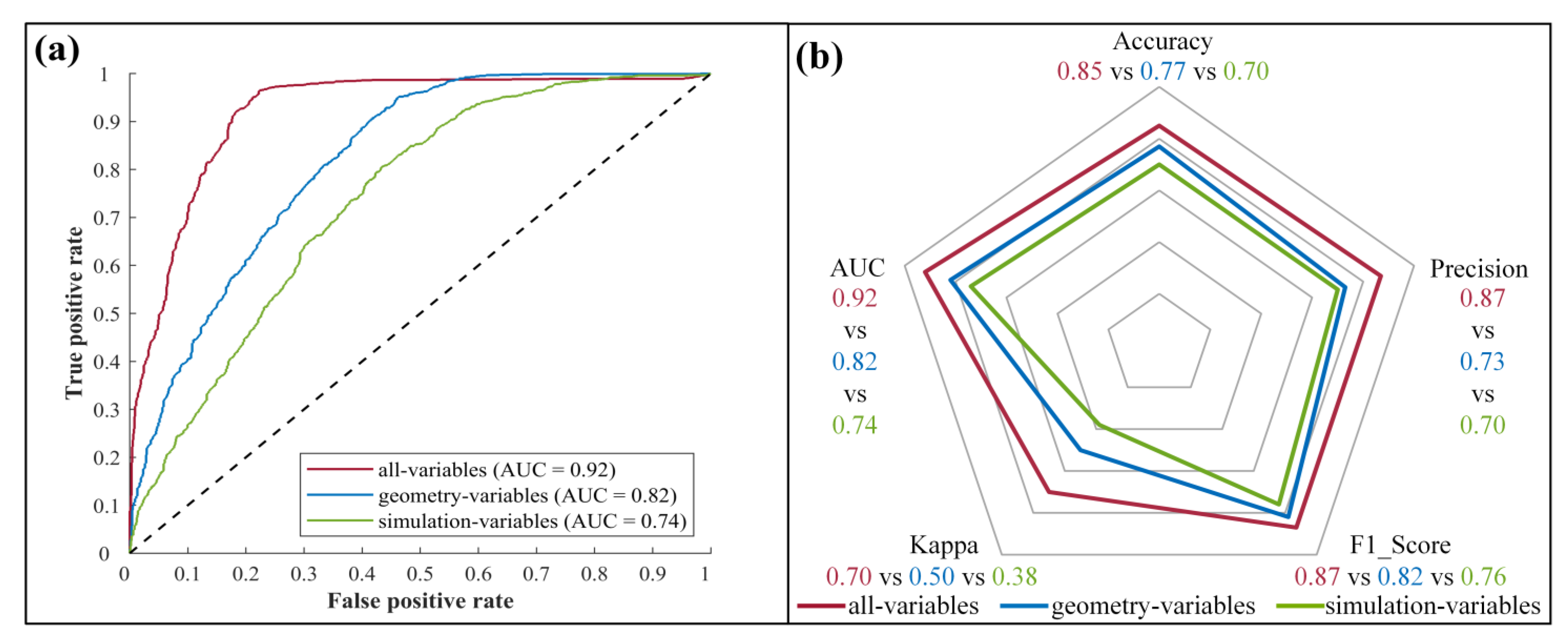
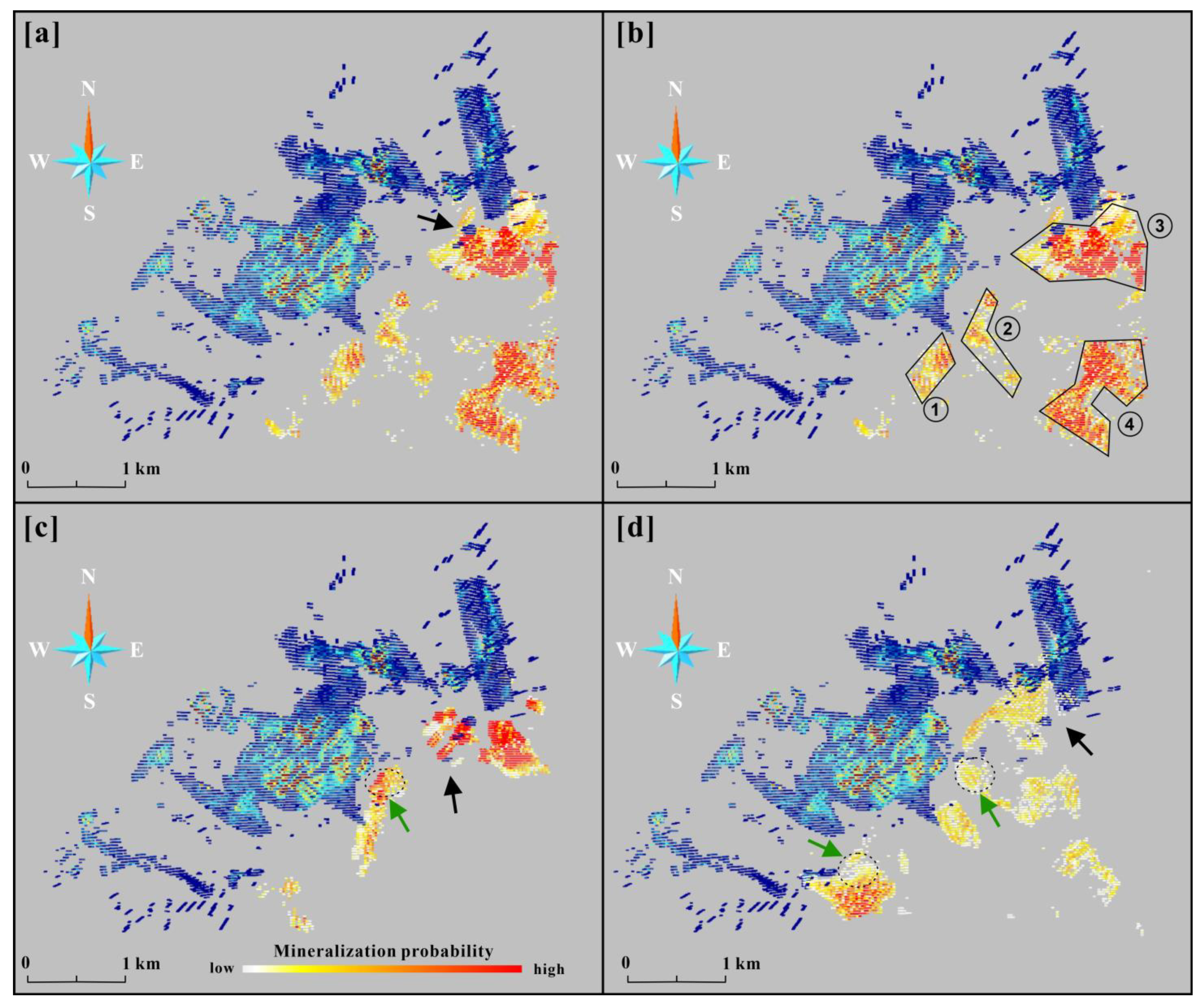
| Variable | Definitions | Unit | Range/Mean |
|---|---|---|---|
| Au | Gold grade of one voxel | g/t | 0~13.4/0.92 |
| AuMet | Gold amounts of one voxel | g | 0~303,532/7784 |
| dF | Minimum distance to the Zhaoping fault | m | −416~113/−117 |
| gF | Dip of the Zhaoping fault | ° | 8.8~89/47 |
| vF | Dip variation of the Zhaoping fault in a 100 m buffer | °/100 m | −15.2~45.6/3.2 |
| waF | Undulation relative to trending surface of the Zhaoping fault in a 180 m buffer | m | −164~96/−15.7 |
| wbF | Undulation relative to trending surface of the Zhaoping fault in a 360 m buffer | m | −111~101/−13.5 |
| Property | Hanging Wall (Metamorphic Rocks) | Footwall (Granite) | Fault Zone |
|---|---|---|---|
| Density | 2.67 | 2.6 | 2.0 |
| Bulk modulus () | 3.28 | 5.33 | 0.52 |
| Shear modulus () | 0.56 | 0.32 | 0.031 |
| Cohesion () | 8.9 | 33.6 | 16.9 |
| Tensile strength (Pa) | 3.77 | 5.16 | 2.97 |
| Friction angle (°) | 28 | 33 | 20 |
| Dilation angle (°) | 3.2 | 5.3 | 6.0 |
| Porosity | 0.29 | 0.19 | 0.4 |
| Permeability () | 2.09 × 10−11 | 1.81 × 10−11 | 1.00 × 10−10 |
| Conductivity () | 2.63 | 3.05 | 4.0 |
| Thermal expansion coefficient (°C−1) | 5.40 × 10−6 | 6.70 × 10−6 | 6.70 × 10−6 |
| Specific heat capacity () | 803 | 803 | 783 |
| Models | MAE | MSE | RMSE | R | R2 |
|---|---|---|---|---|---|
| all-variable model | 2.74 | 41.60 | 6.45 | 0.92 | 0.85 |
| geometry variable model | 3.26 | 44.89 | 6.70 | 0.79 | 0.62 |
| simulation variable model | 4.44 | 65.44 | 8.09 | 0.74 | 0.55 |
Disclaimer/Publisher’s Note: The statements, opinions and data contained in all publications are solely those of the individual author(s) and contributor(s) and not of MDPI and/or the editor(s). MDPI and/or the editor(s) disclaim responsibility for any injury to people or property resulting from any ideas, methods, instructions or products referred to in the content. |
© 2023 by the authors. Licensee MDPI, Basel, Switzerland. This article is an open access article distributed under the terms and conditions of the Creative Commons Attribution (CC BY) license (https://creativecommons.org/licenses/by/4.0/).
Share and Cite
Liu, Z.; Guo, Z.; Wang, J.; Wang, R.; Shan, W.; Zhong, H.; Chen, Y.; Chen, J.; Deng, H.; Mao, X. Three-Dimensional Mineral Prospectivity Modeling with the Integration of Ore-Forming Computational Simulation in the Xiadian Gold Deposit, Eastern China. Appl. Sci. 2023, 13, 10277. https://doi.org/10.3390/app131810277
Liu Z, Guo Z, Wang J, Wang R, Shan W, Zhong H, Chen Y, Chen J, Deng H, Mao X. Three-Dimensional Mineral Prospectivity Modeling with the Integration of Ore-Forming Computational Simulation in the Xiadian Gold Deposit, Eastern China. Applied Sciences. 2023; 13(18):10277. https://doi.org/10.3390/app131810277
Chicago/Turabian StyleLiu, Zhankun, Zhenyu Guo, Jinli Wang, Rongchao Wang, Wenfa Shan, Huiting Zhong, Yudong Chen, Jin Chen, Hao Deng, and Xiancheng Mao. 2023. "Three-Dimensional Mineral Prospectivity Modeling with the Integration of Ore-Forming Computational Simulation in the Xiadian Gold Deposit, Eastern China" Applied Sciences 13, no. 18: 10277. https://doi.org/10.3390/app131810277
APA StyleLiu, Z., Guo, Z., Wang, J., Wang, R., Shan, W., Zhong, H., Chen, Y., Chen, J., Deng, H., & Mao, X. (2023). Three-Dimensional Mineral Prospectivity Modeling with the Integration of Ore-Forming Computational Simulation in the Xiadian Gold Deposit, Eastern China. Applied Sciences, 13(18), 10277. https://doi.org/10.3390/app131810277









